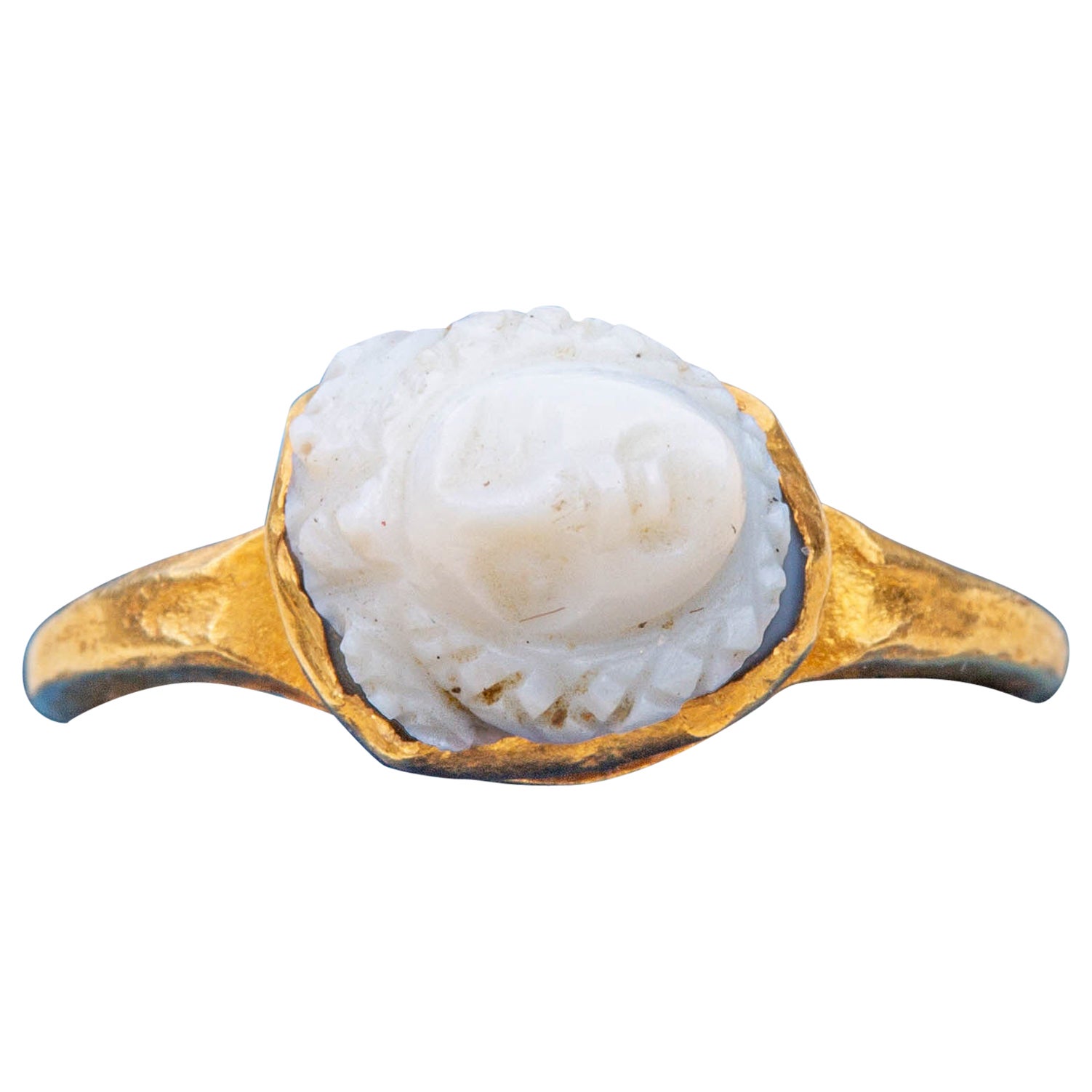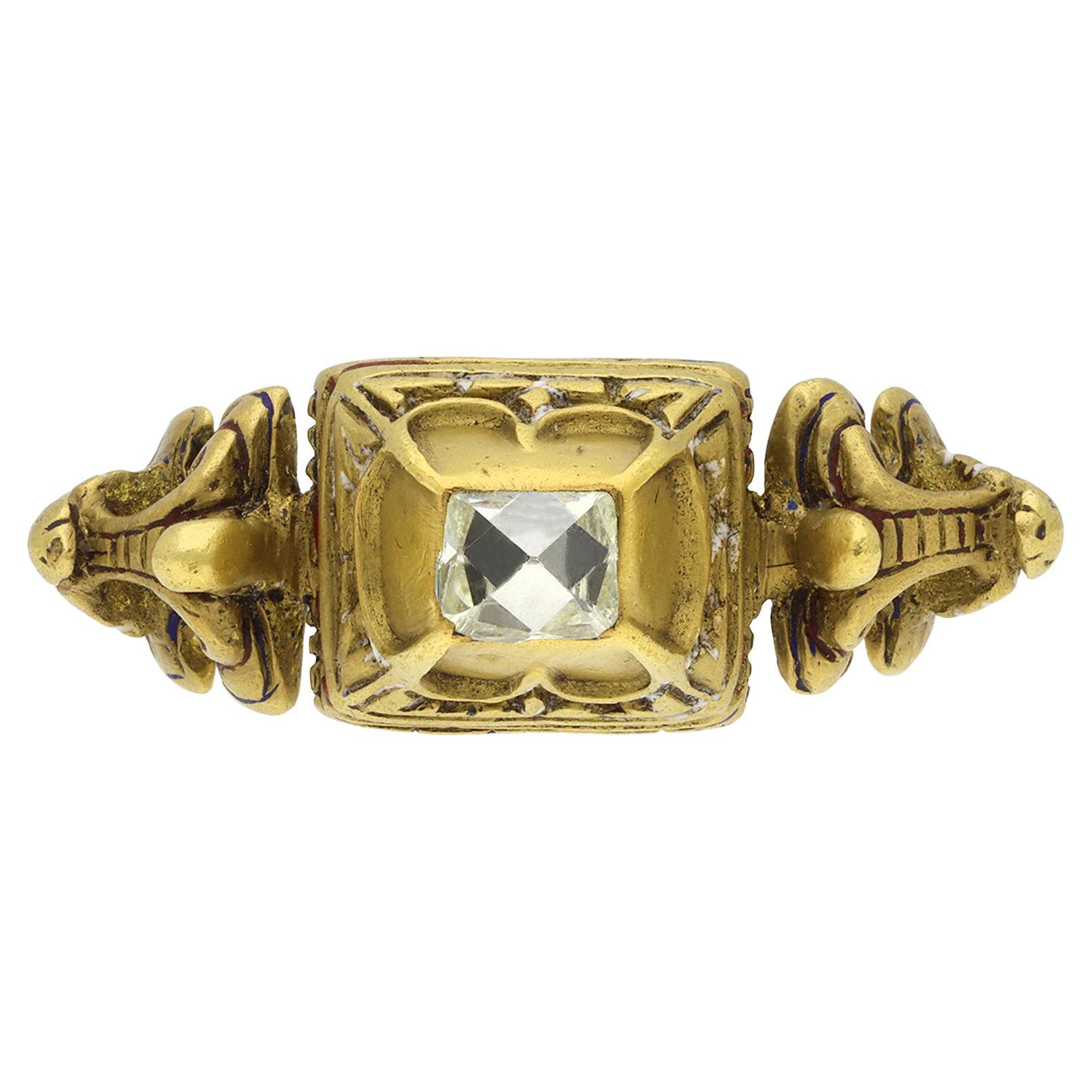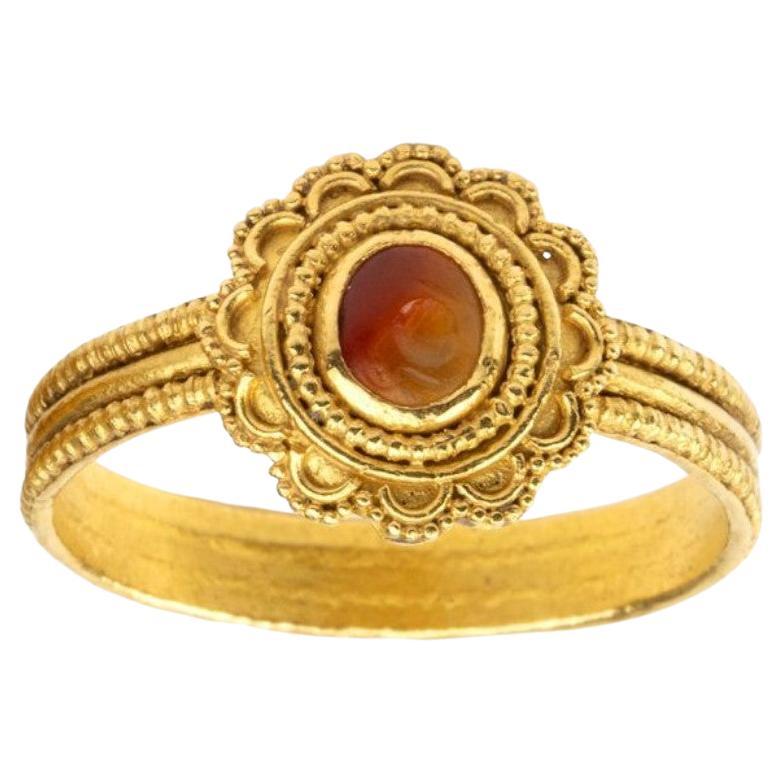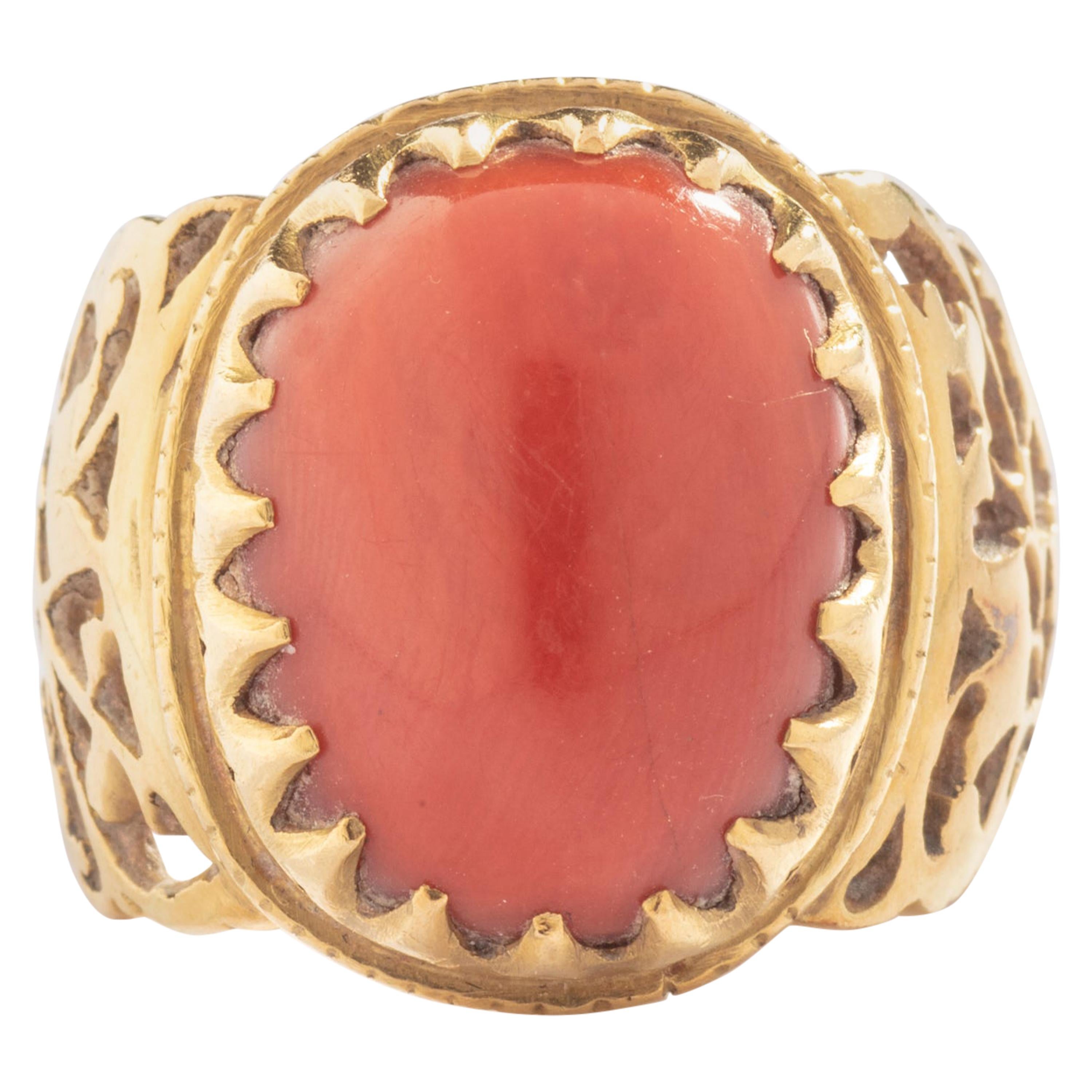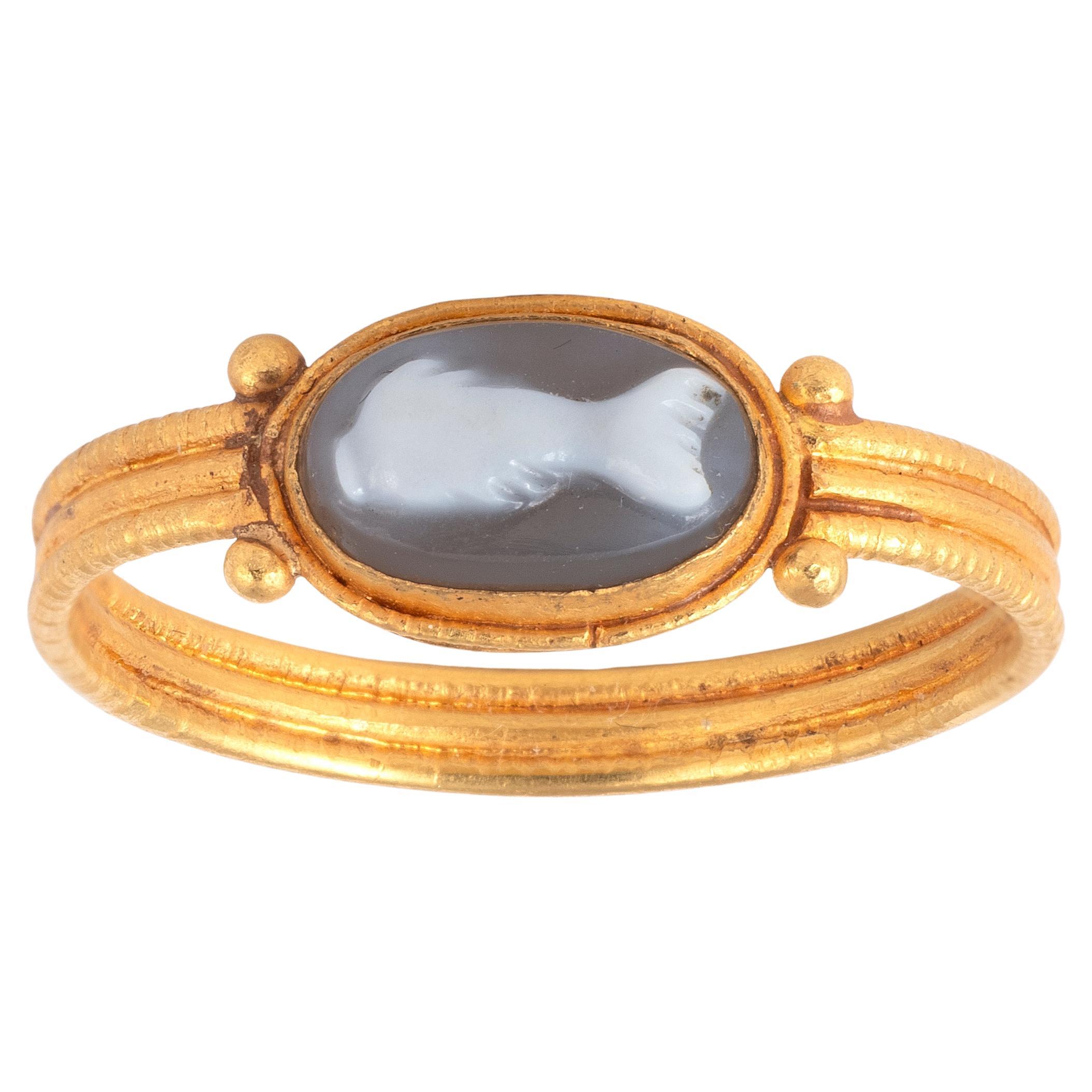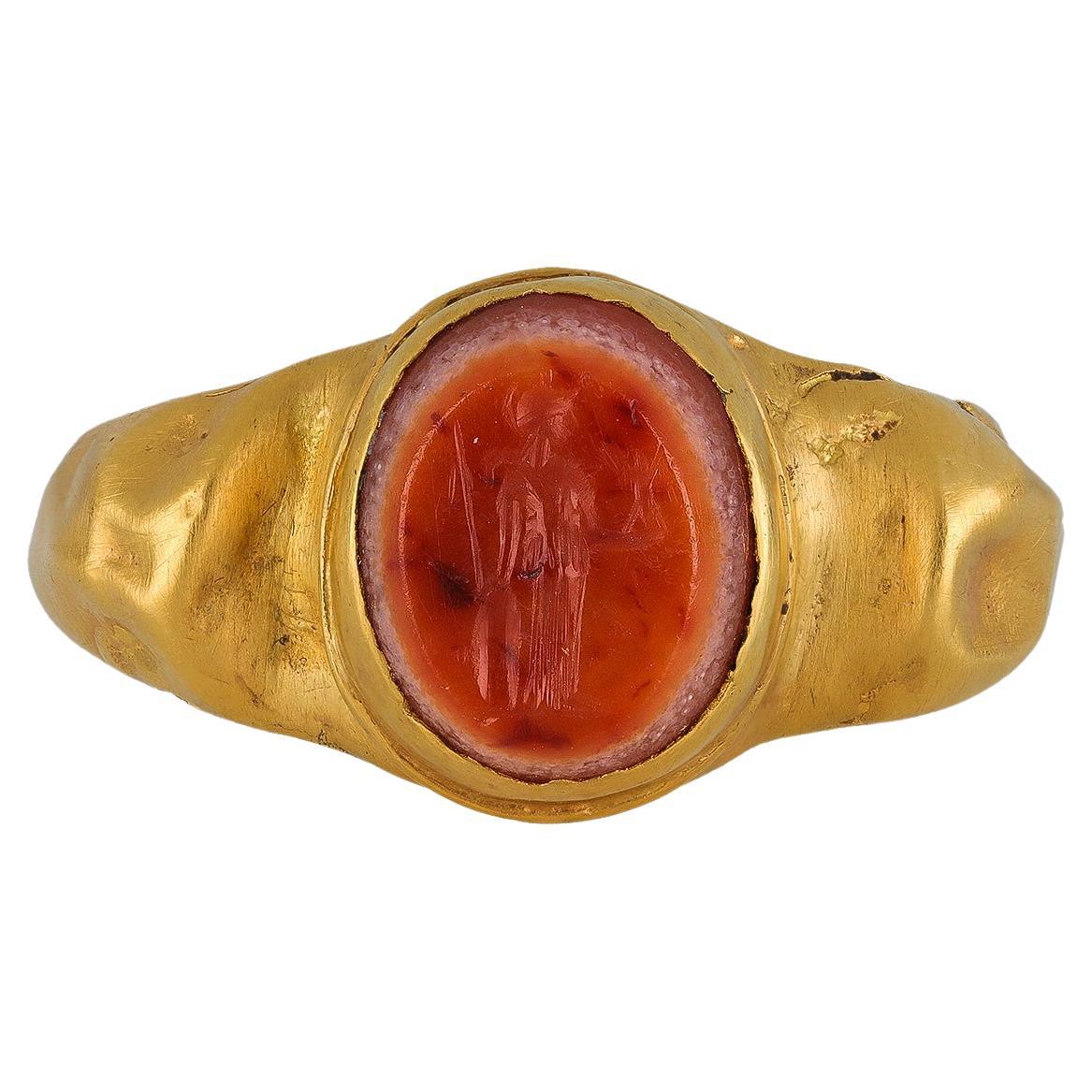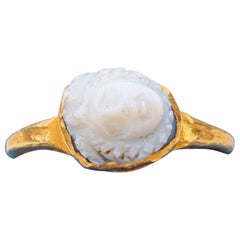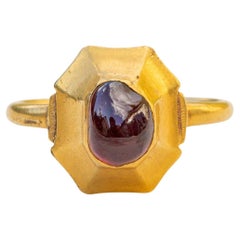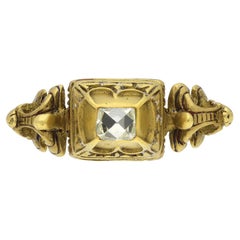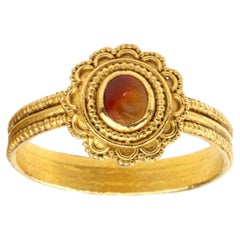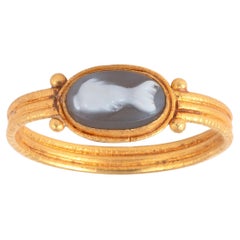Items Similar to Rare Elizabethan 16th Century Gold Cupid Ring Renaissance Gold Ring Womens
Want more images or videos?
Request additional images or videos from the seller
1 of 14
Rare Elizabethan 16th Century Gold Cupid Ring Renaissance Gold Ring Womens
$10,708.71
£7,810
€9,108.64
CA$14,663.89
A$16,304.25
CHF 8,513.18
MX$198,462.41
NOK 108,624.46
SEK 101,775.93
DKK 67,979.44
Shipping
Retrieving quote...The 1stDibs Promise:
Authenticity Guarantee,
Money-Back Guarantee,
24-Hour Cancellation
About the Item
This exquisite Elizabethan gold ring dates to the mid-16th century (c.1570) and features a circular bezel set with a high-relief cameo of Cupid, delicately carved in white chalcedony. Cameos of Cupid, or Eros, were a popular motif during the Renaissance period, symbolising love and desire.
The bezel is encircled by traces of red enamel interspersed with white dots, remnants of its original decoration, lending a vivid glimpse into its once vibrant appearance. The beautifully scrolled shoulders, likely once enamelled, exhibit the elaborate craftsmanship typical of the Renaissance.
Discovered in Essex by a metal detectorist before 1997, this ring is a striking example of Renaissance jewellery with its typical combination of a high-relief bezel, sculptural shoulders, and bold use of enamel. Delicate yet wearable, this rare ring is unmarked but tests as approximately 22k gold. It weighs 2.36 grams, with a band measuring 1.5mm at the back and widening to 9mm at the bezel. The cameo itself measures 5mm across.
This ring is a UK size I 1/2 (US size 4.5) and serves as a tangible piece of history, offering a connection to the Elizabethan period's enduring fascination with mythology and artistic detail.
- Ring Size:4.5 US, Not Resizable
- Metal:
- Stone:
- Stone Cut:
- Weight:2.36 g
- Style:
- Place of Origin:
- Period:
- Date of Manufacture:1570
- Condition:
- Seller Location:London, GB
- Reference Number:Seller: 101591stDibs: LU2845224952012
About the Seller
5.0
Vetted Professional Seller
Every seller passes strict standards for authenticity and reliability
Established in 2019
1stDibs seller since 2022
46 sales on 1stDibs
- ShippingRetrieving quote...Shipping from: London, United Kingdom
- Return Policy
Authenticity Guarantee
In the unlikely event there’s an issue with an item’s authenticity, contact us within 1 year for a full refund. DetailsMoney-Back Guarantee
If your item is not as described, is damaged in transit, or does not arrive, contact us within 7 days for a full refund. Details24-Hour Cancellation
You have a 24-hour grace period in which to reconsider your purchase, with no questions asked.Vetted Professional Sellers
Our world-class sellers must adhere to strict standards for service and quality, maintaining the integrity of our listings.Price-Match Guarantee
If you find that a seller listed the same item for a lower price elsewhere, we’ll match it.Trusted Global Delivery
Our best-in-class carrier network provides specialized shipping options worldwide, including custom delivery.More From This Seller
View AllSmall Ancient Roman Medusa Carved Cameo Gold Ring 2nd Century Gem Carving
Located in London, GB
A scarce and small ancient Roman gold Medusa cameo ring, circa 2nd to 3rd century AD.
The carved layered onyx gemstone is white in colour and depicts the bust of Medusa engraved wit...
Category
Antique 15th Century and Earlier Italian Classical Roman Signet Rings
Materials
Onyx, Gold
Antique Gold Indonesian Bali Garnet Ring 19th Century Hummingbird Gold Ring
Located in London, GB
A scarce late 19th century gold ‘priest’s ring’ from the island of Bali, Indonesia.
The ring is a fantastic example of the southern Balinese style, where ...
Category
Antique Late 19th Century Engagement Rings
Materials
Gold
Italian Baroque Turquoise Gold Bow Ring Antique 18th Century Engagement Ring
Located in London, GB
An unusual example of a scarce seven-stone bow ring dating from the early 18th century, circa 1700. The ring was made in Italy (possibly Sicily) and is a fine example of the beauty o...
Category
Antique Early 1700s Italian Baroque Band Rings
Materials
Turquoise, Gold
Scarce Medieval Gold Garnet Ring Antique 13th Century Talisman Signet Ring
Located in London, GB
An exceptionally rare late 13th century Medieval period gold ring, made either France or England, circa 1280!
This Medieval high-karat gold ring is set with a large 11ct irregular-s...
Category
Antique 15th Century and Earlier European Engagement Rings
Materials
Garnet, 22k Gold
Ancient Roman Gold Mens Signet Ring Conical Intaglio Ring Gem Carving
Located in London, GB
A superb ancient Roman agate intaglio ring. The high-karat gold signet ring is set with an engraved gemstone, known as an ‘intaglio’. It dates from between the 2nd to 3rd century AD and is a fine example of a Romano-British intaglio.
The conical-shaped agate gemstone displays various bands of colour ranging from honey brown to greyish-blue. The engraving depicts the bust of a man wearing a helmet, possibly winged which would depict Mercury, the Roman god of commerce, financial gain and communication. In Roman times, people would wear rings with the intaglio of Mercury in hope that the he would protect them and bless them with good financial fortune in their lives.
A number of referenced examples of similar ancient Roman conical shaped intaglios reside in notable museums all across the world, from the British Museum to the Louvre. A page with these examples and their sources can be found in the final photos of the listing. Similar examples can also be found in the extensive Alice and Louis Koch collection (items: 234, 235, 241, 301). Again see final images for reference.
The gold ring mount is of D-shaped cross-section and a hollow 22K gold construction. The ring has a fantastic smooth silk-like texture when worn. It remains in good overall condition and the intaglio is very secure in the mount. The gold mount dates to the late 18th to early 19th century, and the shape is inspired by ancient Roman ring...
Category
Antique 15th Century and Earlier Signet Rings
Materials
Agate, 22k Gold
Ancient Gold Amethyst Engraved Scorpion Ring Early Javanese Intaglio Ring
Located in London, GB
This scarce gold intaglio ring dates to the Indonesian Classical period, circa 8th–10th century.
The ring is crafted from high-karat gold (22K), featuring a circular bezel that holds an amethyst gemstone engraved with a scorpion motif. Scorpions were often considered symbols of protection in ancient traditions, aligning with Javanese beliefs that rings possessed magical properties to bring good fortune and guard against harm.
The stirrup-shaped shoulders, designed to mimic the form of water buffalo horns, are a hallmark of early Javanese craftsmanship. This distinctive design reflects both artistic expression and cultural symbolism rooted in Java’s agricultural and spiritual traditions.
Java, one of Indonesia’s largest islands, was a significant centre of civilisation and artistry during this period. Gold rings were not merely decorative but also served as currency, payment for fines, dowries, and even wedding feasts. Imported gemstones, like the present amethyst, were chosen for their astrological, magical, and medicinal properties, further enhancing their importance in Javanese society.
Referenced Examples:
Similar rings can be found in the Metropolitan Museum of Art (Accession No. 1998.544.298).
Additional examples are catalogued in Java Gold...
Category
Antique 15th Century and Earlier Engagement Rings
Materials
Amethyst, 22k Gold
You May Also Like
Antique Renaissance 16th Century Diamond Gold Ring
Located in London, GB
Renaissance diamond ring. An impressive 16th century ring, set with a square point cut diamond in a closed back rubover setting with an approx...
Category
Antique 16th Century Unknown Renaissance Solitaire Rings
Materials
Diamond, Yellow Gold
Yellow Gold And Agate Archaeological-Style Ring
Located in Firenze, IT
Ring with a flower motif set with agate. Slab work, decorations in cord motif and micro granulation technique.
Size 8
Weight: 3,5gr.
Category
Antique Late 19th Century Italian Etruscan Revival Fashion Rings
Materials
Agate, Yellow Gold
Antique Etruscan Revival Yellow Gold 18 Karat Ring
Located in Geneva, CH
Antique Etruscan Revival yellow Gold 18k Ring centered by a cabochon coral.
Early 20th Century.
Ring size: 6.
Category
Early 20th Century Italian Etruscan Revival Fashion Rings
Materials
Yellow Gold
Ancient Roman Gold ring with Agate Cameo Fish , circa 2nd Century AD
Located in Firenze, IT
The 2nd century ring has a gold frame with two grooves and gold globules welded to the upper junction, where is set a Roman cameo in agate, depicting a fish. This is a subject that w...
Category
Antique 15th Century and Earlier Italian Classical Roman Signet Rings
Materials
Agate, Gold, 22k Gold
Ancient Roman gold ring with agate intaglio of Minerva, circa 2nd - 3rd century
Located in London, GB
Ancient Roman gold ring with agate intaglio of Minerva. Set with an oval banded agate intaglio to centre of the standing goddess Minerva with long robes and helmet, holding a winged statue...
Category
Antique 15th Century and Earlier Classical Roman Signet Rings
Vintage Handmade 14K Yellow Gold Band Ring with Assorted Precious Colored Stones
Located in Palm Beach, FL
This intriguing and impactful, vintage 14K yellow gold band ring is prong set with a principal natural cabochon emerald weighing approximately 4.00ct surrounded by twenty bezel and p...
Category
Mid-20th Century Unknown Artisan Band Rings
Materials
Amethyst, Beryl, Citrine, Emerald, Garnet, Rubelite, Ruby, Sapphire, Tou...
More Ways To Browse
Antique 16Th Century Jewelry
High Relief Cameo
Cupid Jewelry
White Cameo Rings
Renaissance Cameo
Cupid Ring
Rare Antique Cameo Rings
22k Cameo
Vintage Omega Dials
Cartier Blue Dial
Rolex Datejust 26mm Diamond Bezel
Signet Ring 8
36 Mm Watches
Russian Gold Band
Silver Roman Ring
25 Carat Rose Cut Diamond
Antique Victorian Turquoise Jewelry
Bulgari Watches
